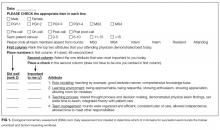Contextual influences of trainee characteristics and daily workload on trainee learning preferences
We previously defined teaching domains necessary for successful inpatient medicine attending rounds from the trainees’ perspective in Role Modeling, Learning Environment, Teaching Process and Team Management. We sought to understand whether trainee characteristics and daily fluctuations in workload influence the prioritization of these domains. We conducted a prospective observational study in general medicine inpatient wards at a university, Veterans Affairs, and a county hospital affiliated with one academic institution over the course of 6 months. All student and resident trainees on internal medicine inpatient wards were eligible to participate. We designed a daily assessment tool on which trainees were asked to identify the teaching domain most important to them, along with information on sex, training level, call-cycle day, patient census, and number of team members absent during rounds. We examined associations between training level and workload factors with the prioritized teaching domain using Pearson’s chi-square analysis, adjusted for clustering effects. We collected 1,378 daily assessment cards evaluating 53 (91%) attending physicians. Students valued Teaching Process (P < 0.001), while senior residents sought Team Management (P < 0.001). On most days, Teaching Process was prioritized (P = 0.005). On post-call days and days with a high patient census, Team Management was prioritized (P < 0.001). Attending physicians may consider tailoring rounds in response to work-related pressures. Days with a high workload are better suited for demonstrating efficient and effective patient care skills. Journal of Hospital Medicine 2017;12:558-561. © 2017 Society of Hospital Medicine
© 2017 Society of Hospital Medicine
We previously identified key domains of attending attributes for successful rounds1 and adapted them to represent the trainees’ perspective: Teaching Process (eg, sharing decision-making process, physical exam skills), Learning Environment (eg, being approachable, respectful), Role Modeling (eg, teaching by example, bedside manner), and Team Management (eg, efficiency, providing autonomy). Though all domains are necessary, the relative importance may change in response to external pressures. Inpatient service demands and time constraints fluctuate daily due to patient admissions and discharges, educational conference schedules, and concurrent outpatient clinic responsibilities.2–4 Furthermore, the 2011 Accreditation Council for Graduate Medical Education (ACGME) duty hour rules placed greater time pressure on inpatient ward attending rounds.5 It is plausible that these pressures affect trainees’ needs and priorities during rounds.
Therefore, we sought to refine our understanding of the learners’ needs during ward rounds. Because we were interested in the contextual influences of trainee characteristics and workload on their preferences, we used the principles of ecological momentary assessment (EMA) to design a novel system to assess daily changes in trainee priorities and associated workload.
METHODS
Design, Participants, and Setting
In a prospective observational study, we assessed trainee priorities during inpatient rounds. Participants included third- and fourth-year medical students in the University of Alabama at Birmingham (UAB) School of Medicine (Birmingham campus) and residents in the Tinsley Harrison Internal Medicine Residency Training Program assigned to inpatient general medicine ward services from September 2010 to February 2011 (except from December 20, 2010, to January 3, 2011). Three training sites were included in this study: UAB Hospital (>1000-bed, university-based hospital), Birmingham Veterans Affairs Medical Center (300-bed), and Cooper Green Hospital (40-bed county hospital). Each site housed 4 or 5 general medicine ward teams, composed of 1–3 medical students (third or fourth year), 2 first-year residents, 1 upper level resident (postgraduate year 2–4), and 1 attending physician.
Trainees were recruited to participate via e-mail and verbal announcements during program conferences. Participation was voluntary and responses were confidential. As an incentive, the team submitting the highest number of cards per site each month received 1 free lunch. Institutional review boards of all 3 participating hospitals approved this study.







